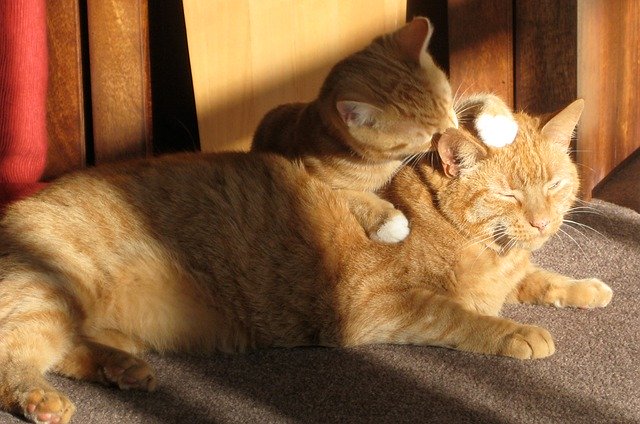Have you got the cutest kitten in the litter but not sure what sex it is? Or maybe you connected with it before you thought about the sex, and now you need to find it a suitable name.
While it may seem challenging, determining your kitten’s sex can be easy once you know what to look out for.
In this article, we’ll outline some things that indicate whether a kitten is male or female. We’ll also look at some factors to consider when getting a new kitten.
Table of Contents
How to Tell the Gender of a Cat
Though not 100% accurate, one of the ways to guess the gender of a kitten is by observing the coat color.
For example, cats with three colors, aka tortoiseshell cats, are usually females. This is because; the chromosomal makeup of female cats is responsible for this coloration.
On the other hand, it is more common to find orange or ginger kittens as males than females. Even then, this is still not entirely reliable.
When Determining the Gender of the Kitten
Now, while you’re undoubtedly curious about the sex of your kitten, especially if your cat birthed them, you do not want to disrupt the mother-kitten bond in the first few weeks of life. This is because mother cats sometimes completely abandon their kittens and even stop feeding them altogether if they’re handled too much during this time.
Instead of separating them every time to check for the traits, please wait a few weeks or even longer before handling them.
Also, when trying to determine the gender of your cat, you should ensure that you minimize the stress level. For a really young kitten, you want to start by gently picking him up, petting him, and snuggling him close to your body while you examine the areas in question. If you notice your kitten is panicky, you should leave the activity for another day. If you're cat is really scared, we have shared some other tips on dealing with a frightened kitten here.
Identifying Your Kitten’s Genitals
From two weeks of age, you will observe differences that will help you identify the sex of your kitten.
The genitals will look like an upside-down exclamation point for female kittens with the vertical vaginal slit just below the anus. You’ll also observe a little spacing just between the slit and anus.
On the male kitten, the genitals look like a colon; the penis sitting just below the anus and separated by enough space to contain the testicles. You may also spot two small lumps in that space, and these eventually grow bigger as your kitten matures.
If you’re still unsure which your kitten’s genital is upon visual observation, pick one and place your finger and thumb gently on either side of the scrotum areas if you suspect it’s a male.
You should be able to feel two small, hard, oval-shaped objects under the skin. These are the testes, and at this point, they are nearly impossible to hold because of how they slide from your fingers. If the testes are present, then the kitten is most certainly a male.
Determining a Kitten’s Gender Through Its Behavior
As they grow older, our kittens' behavior is another way to tell the sexes apart. This is because, as felines grow older, they begin to develop personalities/behaviors that are unique to their sexes.
For example, male kittens often start to roam as they reach sexual maturity. Most also take it further by becoming territorial and you may notice them spaying to establish their authority in order to ward off trespassers or competitors. The males also are more aggressive and restless.
On the other hand, females tend to go on heat from as early as four months of age. You may notice them yowling loudly or displaying any other attention-seeking behavior.
However, you can significantly reduce all of these behaviors by neutering or spaying the kitten early in their lives. Many pet experts recommend Many pet experts recommend spaying or neutering once your kitten is five to six months, while some others recommend pediatric spaying, which can happen at six to eight weeks.
That said, while some pet owners claim that male cats are friendlier than females, this is not entirely true as cat personalities, just like humans, are varied. So, it may be best to choose a feline based on other characteristics and factors instead of gender.

Choosing a Kitten: Factors to Consider
When getting a kitten, you want to make sure that you pick one that is suitable for your environment. Do you stay alone? Do you have a family with children? Already own cats or other pets before the kitten? These are all factors you should consider before bringing home a new kitten.
This is important because cats have personalities and varying temperaments, just like humans. Apart from that, cats also come in different sizes, body, and fur types, and all of these should be considered before you make a decision.
Also, before you settle for a particular kitten, research all you can about that breed and the behavioral differences individual to the species.
Choosing a Cat Breed
The Cat Fanciers Association commonly thought of as the cat equivalent of the American kennel club officially recognizes 39 breeds of cats. However, whether you’re getting a purebred cat or mixed breed, felines generally share certain characteristics that you take into consideration before settling for one.
Body Type
Felines come in two body types: the Foreign and the Cobby. The Foreign body cat is slim and svelte in appearance (think Siamese), while the Cobby body type has short legs and a broad chest (the American shorthair).
Because all cats cannot be fully categorized into either of the two, the word “semi” can sometimes refer to felines with a tendency towards either of the body type.
Size
Depending on the breed type and sex, full-grown kittens can weigh between 4 to over 20 pounds. Put that into consideration before settling for one, especially if you envisioned getting the small-sized cat.
Fur Length
While there are hairless cat breeds such as the Sphynx, most cat breeds have full coats. These coats can vary in length, but they’re typically described as short, medium, and long-haired.
Long-haired cats require frequent grooming; hence, it should be a major consideration when choosing a cat. You may want to consider opting for a short-haired cat if you’ll cannot keep up with frequent grooming. Here you can see our list of cats that do no shed.
Fur Colors and Patterns
Our felines’ fur colors are often shaded, tipped, or banded. The coat colors can range from black to white and orange to blue. However, note that color descriptions are a lot different from what you imagined with felines.
“Seal,” for example, is a “dark brown,” while the “blue” is a “medium grey.” The patterns may also range from solid to mixtures. While calicos have clearly defined bright patches of colors, tabbies are usually spotted or striped, so you will have to decide which you prefer if the fur color is one of the deciding factors for you.
Cat’s Activity Level
As said earlier, cats, like humans, come with different personalities, which means different activity levels, though some of these personalities may be unique to certain breeds.
Certain kinds of cat breeds may be better suited for homes with small children or as lap pets e.g. the Persian or the American shorthair.
If you’re looking to get a playful and active cat, you should consider a lively breed such as the American bobtail, Abyssinian cat, or others like them.
Other Things to Remember When Choosing a Cat
Kittens should never be entirely separated from their mothers until they’re about 10 – 12 weeks old. Kittens require and learn valuable skills such as proper socialization and litter box use from their mom.
If you’re getting a cat from the breeder, make sure it has been vaccinated before taking it home. You should also book an appointment with your vet for a general wellness check even after the vaccination.
Because our fur babies are like our human children in certain ways, you want to ensure that the house is completely “cat proof” (removing all dangerous objects and making hazardous areas inaccessible to the cat) before bringing the feline home.
Final Thoughts
Bringing any feline home can be an exciting new experience, whether male or female. Cats generally have traits you’ll find intriguing, so unless you’re getting it for breeding purposes, the sex shouldn’t really matter so much. If you want to know how to tell if a kitten is male or female, you should now have your answer.
Whichever sex your kitten ends up being, learn all you can about it; its breed type, behaviors particular to its sex, and just anything that would help you and your new feline enjoy a truly happy and rewarding relationship. You can see our top tips here on how to raise a healthy kitten.
About the Author
Kirsten Heggarty
Kirsten created The Pet Handbook with the aim of sharing her knowledge about pets, pet food, healthy habits, and more. All of her advice is based on years of her own experience with her pets, and feedback that she has received from grateful readers about her tips. If you want to know more please read the About Me page.









